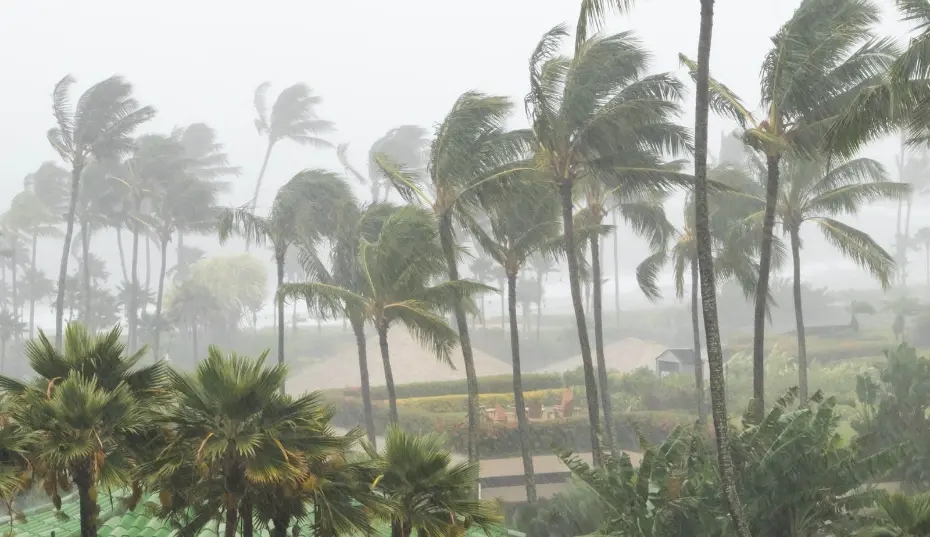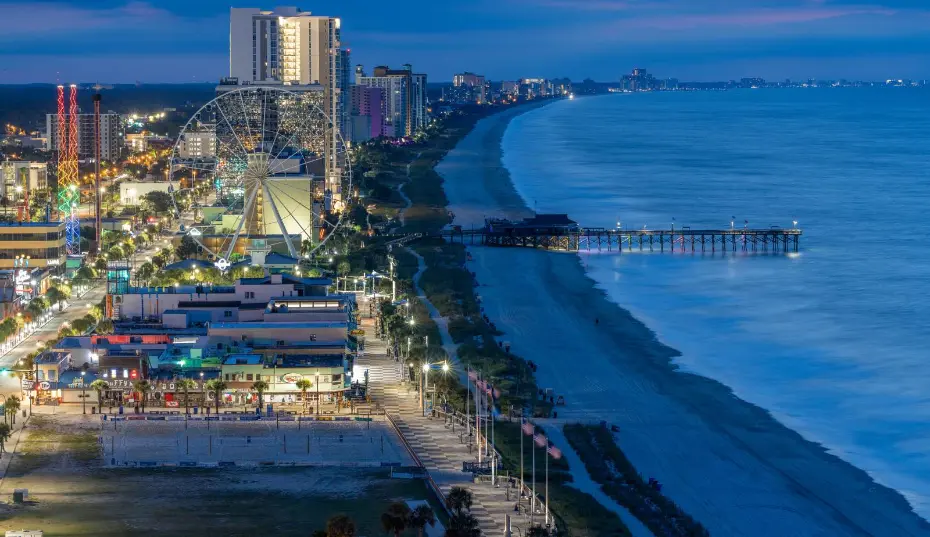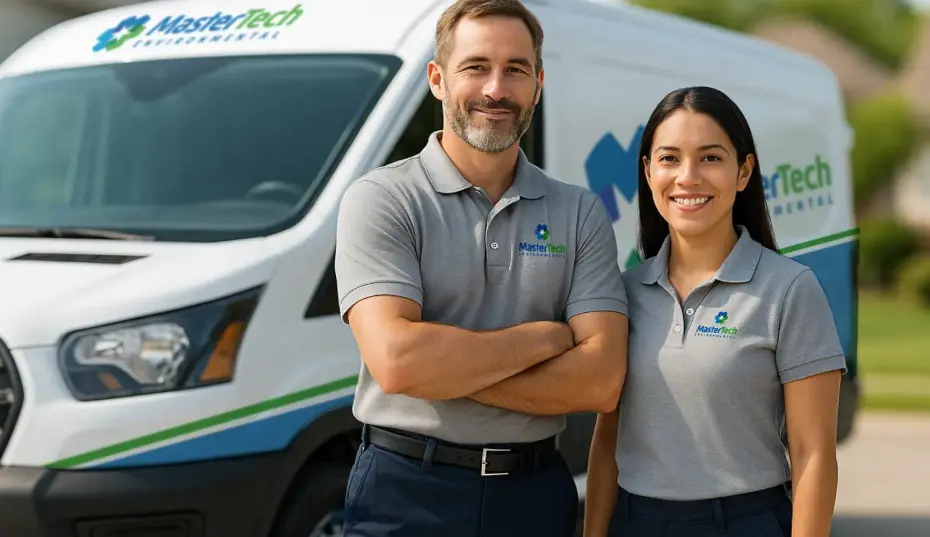Hurricane season presents significant challenges for homeowners in Myrtle Beach, particularly concerning mold growth. The region's warm, humid climate creates an ideal environment for mold, especially after heavy rainfall or flooding. To mitigate the risks associated with mold following a hurricane, homeowners must proactively address potential water damage and maintain good indoor ventilation.
As storms pass through, the combination of elevated humidity levels and the remnants of water can lead to rapid mold growth, often within just 24 to 48 hours. Many homeowners may overlook this hidden threat, unaware that it can compromise both their health and property. Awareness of these risks is essential for effective mold prevention and remediation, ensuring a safe living environment in the wake of stormy weather.
In Myrtle Beach, understanding the effects of hurricane seasons on mold growth is crucial. By taking appropriate action, such as monitoring indoor humidity and addressing water damage promptly, homeowners can protect their investments and well-being. This article will explore the specific risks of mold after hurricanes, providing practical solutions to safeguard homes throughout the hurricane season.
Understanding Hurricane Season Mold Risks
Hurricane season poses significant risks for mold growth in Myrtle Beach homes. The interaction of high humidity, moisture, and the structure of homes creates ideal conditions for mold to thrive. This section delves into how hurricanes contribute to increased moisture levels, why homes in Myrtle Beach are particularly vulnerable, and the implications of mold growth following storms.
How Hurricanes Increase Moisture Levels
Hurricanes bring heavy rainfall and strong winds that can result in significant water infiltration. As storms approach, humidity levels surge.
- Precipitation: Hurricanes can unleash several inches of rain, overwhelming drainage systems and leading to flooding.
- Wind Damage: High winds can damage roofs, windows, and siding, allowing water entry into homes.
These conditions facilitate prolonged moisture exposure, fostering an environment in which mold can flourish. Even residual moisture after a storm can contribute to mold development.
Why Myrtle Beach Homes Are Vulnerable
Myrtle Beach homes often face unique challenges that increase mold susceptibility.
- Climate: The coastal climate is characterized by high humidity and warmth, ideal for mold growth.
- Construction Styles: Many homes have crawl spaces and attics that can trap moisture if not properly ventilated.
Additionally, the prevalence of outdoor landscaping and vegetation near homes can contribute to humidity levels. If these factors are not addressed, they can lead to significant mold issues in the aftermath of a hurricane.
Mold Growth After Storms
After a storm, the presence of mold can pose serious health risks.
- Timeline: Mold can begin to grow within just 24 to 48 hours after water exposure.
- Health Concerns: Exposure can lead to respiratory problems, allergic reactions, and other health issues.
Timely interventions are critical. Homeowners should act quickly to mitigate water damage, improve ventilation, and monitor humidity levels. Proactive steps can prevent minor moisture-related issues from escalating into major mold problems.
Common Mold Sources in Myrtle Beach Residences
Mold can thrive in various areas of Myrtle Beach homes, particularly due to the region's unique climate and weather conditions. Homeowners should be aware of specific sources that can contribute to mold growth, especially following severe weather events.
Roof Leaks and Structural Damage
Roof leaks are a significant source of moisture that can lead to mold development. Heavy rains and storms can cause shingles to curl or break, allowing water to seep into the interior.
Once inside, water can accumulate, especially in attics or ceilings, creating an environment conducive to mold.
Homeowners should inspect roofs regularly and address any signs of damage promptly. Routine maintenance and timely repairs can prevent leaks, thereby reducing the likelihood of mold growth inside the home.
Flooded Basements and Crawl Spaces
Basements and crawl spaces are often vulnerable to flooding, particularly after hurricanes or heavy rain. Water can enter these areas, leading to increased humidity levels and the perfect breeding ground for mold.
Standing water should be removed quickly to minimize potential damage. Homeowners should also consider installing sump pumps or ensuring proper drainage around the home to channel water away effectively.
Regular inspections can help detect leaks or moisture issues before mold takes hold. Proper ventilation in these spaces is essential to reduce humidity and promote drying.
Attic and Wall Cavities
Attics and wall cavities can trap heat and moisture, creating a favorable environment for mold growth. Poor ventilation in attics can increase humidity, especially during summer months.
Any water leaks from roofs or plumbing can exacerbate the problem. Homeowners should inspect attic insulation and ventilation systems to ensure moisture is adequately managed.
Wall cavities, often hidden from view, can harbor mold due to water intrusion from leaks or high humidity within the walls. Regular checks can help identify potential issues early, preventing significant mold infestations.
Health Impacts of Mold Exposure During Hurricane Season
Mold exposure during hurricane season presents significant health risks for individuals in Myrtle Beach. Various respiratory issues and long-term health effects arise, especially for vulnerable populations. Accurate awareness is crucial for prevention and effective management.
Respiratory Concerns and Allergies
Mold spores can trigger serious respiratory problems. Common symptoms include:
- Coughing
- Sneezing
- Nasal congestion
- Throat irritation
Individuals with pre-existing conditions, such as asthma, may experience intensified symptoms. High mold counts can lead to acute asthma attacks, as studies show a direct correlation between mold exposure and increased respiratory issues. According to research, excessive mold can lead to an escalation in asthma medication for affected individuals, particularly children. Prompt identification and remediation of mold in homes are essential for maintaining air quality and health.
Vulnerable Populations in Myrtle Beach
Certain groups are at a heightened risk of adverse health effects from mold exposure. This includes:
- Children
- Elderly individuals
- People with compromised immune systems
Children with asthma are particularly at risk, as mold exposure significantly impacts their health. Studies indicate that children living in mold-affected areas may require increased medical attention, including escalated medication within months of exposure. Seniors and individuals with weakened immune systems should also take preventative measures to minimize risk, given their susceptibility to infections and respiratory illnesses.
Long-Term Health Effects
Persistent mold exposure can lead to lasting health complications. Prolonged contact may result in chronic respiratory conditions or even invasive mold infections.
Symptoms of long-term exposure can include:
- Chronic cough
- Fatigue
- Persistent headaches
Research highlights that the incidence of mold-related infections increased significantly in disaster-stricken areas. Individuals exposed to high mold levels may develop respiratory illnesses that require ongoing medical management. Education on mold health risks and proper remediation measures is vital for maintaining community health, emphasizing prevention strategies that can reduce exposure after hurricanes.
Preventing Mold Damage in Myrtle Beach Homes
Mold damage can pose significant risks to homeowners in Myrtle Beach, especially during hurricane season. Effective prevention strategies are vital to mitigate mold growth caused by moisture and flooding that often accompany severe weather.
Pre-Storm Preparation Steps
Before a hurricane strikes, homeowners should take proactive measures to safeguard their properties.
- Inspect the Property: Check for existing leaks or water damage. Address these issues promptly to prevent further complications.
- Seal Vulnerabilities: Apply weather stripping around doors and windows. Install storm shutters to protect against wind-driven rain.
- Clear Gutters and Drains: Ensure gutters are free of debris for proper drainage. This reduces the risk of water damage during heavy rainfall.
- Develop an Emergency Plan: Create a comprehensive response plan that includes contacting mold remediation professionals if needed.
By preparing in advance, homeowners can significantly reduce the risk of mold-related issues after a storm.
Moisture Control Strategies
Controlling indoor moisture is crucial in preventing mold growth.
- Humidity Levels: Maintain indoor humidity below 60%. Use dehumidifiers, especially in basements and crawl spaces.
- Adequate Ventilation: Ensure proper ventilation in commonly humid areas, such as bathrooms and kitchens. Install exhaust fans to reduce moisture.
- Routine Inspections: Conduct regular inspections for leaks in plumbing and roofing. Look for signs of water intrusion or condensation.
- Mold-Resistant Products: When renovating or building, consider using mold-resistant paints and materials that help prevent mold growth.
These strategies minimize moisture buildup and reduce the likelihood of mold colonization.
Post-Storm Cleaning Protocols
After a hurricane, immediate response actions are essential to address potential mold growth.
- Assess Damage Promptly: After the storm has passed, inspect for visible water damage and mold. Document findings for insurance claims.
- Remove Water Quickly: Begin water extraction within 24 hours. Use pumps or wet/dry vacuums to eliminate standing water.
- Clean and Disinfect: Use a mixture of water and biocidal cleaners to disinfect affected surfaces. Pay attention to porous materials, which may require replacement.
- Air Out the Area: Open windows and doors to enhance airflow. Use fans to speed up the drying process.
- Professional Help: For extensive damage, enlist the services of a mold remediation specialist. They can ensure thorough cleaning and restoration.
Implementing these cleaning protocols promptly helps prevent mold growth and protects the integrity of the home.
Professional Mold Inspection and Remediation
Proper mold inspection and remediation are vital for maintaining a safe living environment, especially in areas like Myrtle Beach prone to the effects of hurricanes. A qualified team ensures thorough assessment and effective removal of mold to protect health and property.
Why Choose Mastertech Environmental
Mastertech Environmental stands out due to its commitment to quality service and customer satisfaction. Their licensed and certified technicians are trained to provide specialized mold inspection and remediation.
- Experienced Professionals: Mastertech has a dedicated team with years of expertise in mold issues specifically related to hurricane impacts.
- Comprehensive Services: They offer more than just mold removal. Their services extend to mold testing, biohazard cleanup, and water damage restoration.
- Customer-Focused Approach: They prioritize open communication and tailor solutions to meet each client’s unique needs.
Process of Mold Remediation
The process of mold remediation at Mastertech is designed to be thorough and effective. It typically includes the following steps:
- Inspection and Assessment: The team conducts a detailed inspection to identify mold presence and assess the extent of damage.
- Containment: They establish containment zones to prevent the spread of mold spores during the removal process.
- Mold Removal: Using industry-standard techniques, the team removes mold from affected areas, ensuring that all colonies are addressed.
- Preventative Measures: After remediation, they apply treatments to help prevent future mold growth.
This structured approach helps ensure that all mold issues are effectively managed.
Certifications and Safety Standards
Mastertech Environmental holds various certifications and adheres to strict safety standards, ensuring high-quality service. Key certifications include:
- IICRC Certified: This denotes a commitment to upholding industry standards in restoration and cleaning.
- Licensed and Insured: Mastertech operates under licensed practices, providing peace of mind to clients regarding liability.
In addition to certifications, they follow safety protocols to protect both their team and the clients during the remediation process. This adherence to safety standards ensures effective and responsible mold removal, thus fostering a healthy living environment.
Insurance Considerations for Hurricane-Related Mold
Understanding insurance coverage for mold remediation is essential, especially following hurricane damage. Homeowners must be aware of their policy specifics and the claims process to effectively manage potential mold issues.
Policy Coverage for Mold Remediation
Homeowners insurance policies can vary significantly in their coverage of mold damage. Many standard policies may have specific exclusions or limitations regarding mold, particularly the conditions under which it is covered.
- Coverage for Mold: Mold remediation may be covered if it results from a "sudden and accidental" event, such as a roof leak caused by hurricane winds.
- Limits on Coverage: Some policies impose caps on mold-related claims, often around $5,000 to $10,000. Homeowners should review their policies to identify these limits before a claim is made.
- Additional Riders: Consider adding a rider for mold coverage if it's not included. This can offer extra security against unexpected mold issues after storms.
Filing Claims After Hurricane Damage
Filing a claim for mold damage requires careful attention to detail. Following these steps can help streamline the process.
- Document Damage: Take clear photos of water damage and mold growth as soon as possible. Detailed documentation supports the claim and showcases the extent of the problem.
- Contact the Insurer: Notify the insurance company promptly about the damage. They may have specific timelines for reporting claims related to storm damage.
- Avoid Common Pitfalls: Homeowners should avoid making unnecessary repairs before the insurance adjuster evaluates the damage. This could affect the claim outcome.
Following these guidelines will enhance the likelihood of a successful claim for hurricane-related mold issues.
Maintaining a Mold-Free Home in Myrtle Beach
Keeping a home in Myrtle Beach mold-free requires a proactive approach. The combination of high humidity and the risk of storms demands specific maintenance strategies to prevent mold growth. Through ongoing home care and a seasonal checklist, homeowners can mitigate mold risks effectively.
Ongoing Home Maintenance Tips
Regular home maintenance plays a crucial role in mold prevention. Here are key tasks to incorporate:
- Inspect Roof and Gutters: Regularly check for leaks and ensure gutters are clear of debris to prevent water accumulation.
- Manage Indoor Humidity: Use dehumidifiers to keep indoor humidity levels between 30% and 50%. Consider using exhaust fans in areas prone to moisture, like kitchens and bathrooms.
- Seal Cracks and Openings: Inspect windows, doors, and foundation for cracks. Use caulk or weather-stripping to seal them effectively.
- Monitor HVAC Systems: Change air filters regularly. Clean and maintain the system to prevent moisture buildup and mold growth within ducts.
- Check Plumbing: Inspect pipes for leaks and fix them promptly to avoid water damage and moisture issues.
Seasonal Mold Prevention Checklist
Seasonal changes in Myrtle Beach can significantly impact mold growth. Here’s a checklist for each season:
-
Spring:
- Conduct a thorough inspection of the home for signs of water damage.
- Clean gutters and downspouts to ensure proper water drainage.
-
Summer:
- Pay close attention to indoor humidity levels.
- Run air conditioning as needed to maintain a cooler environment.
-
Fall:
- Clear outdoor debris that can trap moisture against the home.
- Prepare plumbing for cooler weather by insulating pipes.
-
Winter:
- Check attic insulation and ventilation to prevent condensation.
- Ensure that heating systems are functioning properly to reduce humidity indoors.
Following these maintenance tips and seasonal checks can significantly reduce the chance of mold growth throughout the year.
Frequently Asked Questions
Homeowners in Myrtle Beach often have concerns about mold risks following hurricanes. Recognizing signs of mold growth, understanding prevention methods, and knowing the proper remediation steps can help protect properties and health post-storm.
What are the common signs of mold growth in homes after a hurricane?
Common signs of mold growth include visible patches on walls or ceilings, a musty odor, and water stains. Homeowners may also notice increased humidity levels inside the home or signs of water damage in areas like attics and basements.
How can homeowners prevent mold infestation following heavy rains or flooding?
Homeowners can prevent mold by promptly removing standing water and drying wet areas within 24 to 48 hours. Proper ventilation, using dehumidifiers, and maintaining indoor humidity levels below 60% are effective strategies to deter mold growth.
What is the recommended procedure for removing mold in a storm-damaged property?
The recommended procedure involves isolating affected areas, wearing protective gear, and removing contaminated materials. Surfaces should be cleaned with appropriate solutions, and adequate drying must be ensured to prevent regrowth.
When is the best time to inspect a home for mold after a hurricane has occurred?
The best time for inspection is within 24 to 48 hours after the storm subsides. Early detection is crucial, as mold can begin to grow quickly in damp conditions created by flooding or leaks.
Are there specific areas in a home more prone to mold growth after storm-related damage?
Yes, specific areas prone to mold include basements, attics, and spaces around windows and doors. Bathrooms and areas with plumbing may also be susceptible, especially if they have experienced water intrusion.
What professional mold remediation options are available for residents in Myrtle Beach post-hurricane?
Residents can access several professional remediation options, including thorough inspections, containment of affected areas, and specialized cleaning services. Certified professionals can offer comprehensive solutions tailored to specific mold issues encountered after a hurricane.


